框架理论在中国古诗词翻译中的应用
框架理论下《楚辞》的意象翻译研究
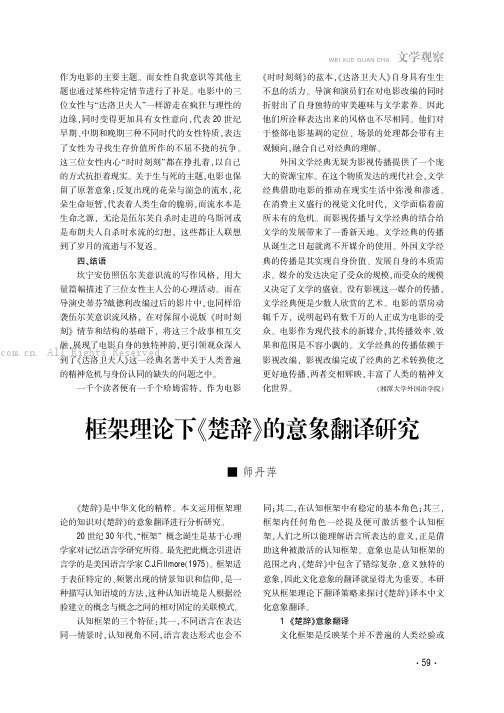
《楚辞》是中华文化的精粹。
本文运用框架理论的知识对《楚辞》的意象翻译进行分析研究。
20世纪30年代,“框架”概念诞生是基于心理学家对记忆语言学研究所得。
最先把此概念引进语言学的是美国语言学家C.J.Fillmore (1975)。
框架适于表征特定的、频繁出现的情景知识和信仰,是一种描写认知语境的方法,这种认知语境是人根据经验建立的概念与概念之间的相对固定的关联模式。
认知框架的三个特征:其一,不同语言在表达同一情景时,认知视角不同,语言表达形式也会不同;其二,在认知框架中有稳定的基本角色;其三,框架内任何角色一经提及便可激活整个认知框架,人们之所以能理解语言所表达的意义,正是借助这种被激活的认知框架。
意象也是认知框架的范围之内,《楚辞》中包含了错综复杂、意义独特的意象,因此文化意象的翻译就显得尤为重要。
本研究从框架理论下翻译策略来探讨《楚辞》译本中文化意象翻译。
1《楚辞》意象翻译文化框架是反映某个并不普遍的人类经验或框架理论下《楚辞》的意象翻译研究■师丹萍作为电影的主要主题。
而女性自我意识等其他主题也通过某些特定情节进行了补足。
电影中的三位女性与“达洛卫夫人”一样游走在疯狂与理性的边缘,同时变得更加具有女性意向,代表20世纪早期、中期和晚期三种不同时代的女性特质,表达了女性为寻找生存价值所作的不屈不挠的抗争。
这三位女性内心“时时刻刻”都在挣扎着,以自己的方式抗拒着现实。
关于生与死的主题,电影也保留了原著意象:反复出现的花朵与湍急的流水,花朵生命短暂,代表着人类生命的脆弱,而流水本是生命之源,无论是伍尔芙自杀时走进的乌斯河或是布朗夫人自杀时水流的幻想,这些都让人联想到了岁月的流逝与不复返。
四、结语坎宁安仿照伍尔芙意识流的写作风格,用大量篇幅描述了三位女性主人公的心理活动。
而在导演史蒂芬?戴德利改编过后的影片中,也同样沿袭伍尔芙意识流风格,在对保留小说版《时时刻刻》情节和结构的基础下,将这三个故事相互交融,展现了电影自身的独特神韵,更引领观众深入到了《达洛卫夫人》这一经典名著中关于人类普遍的精神危机与身份认同的缺失的问题之中。
翻译中的框架操作
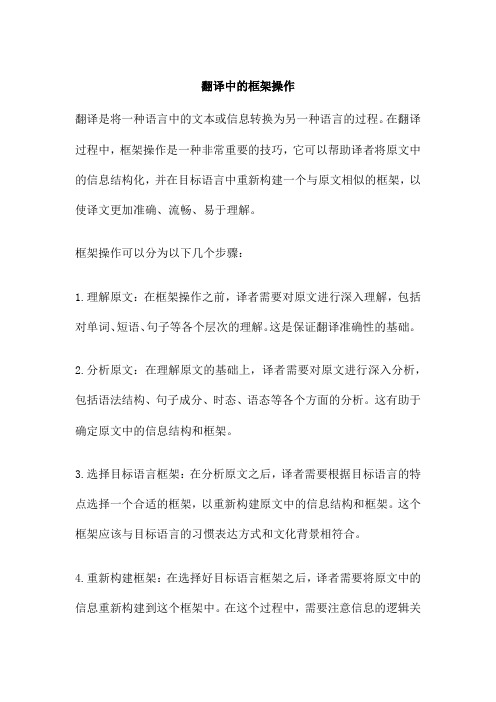
翻译中的框架操作翻译是将一种语言中的文本或信息转换为另一种语言的过程。
在翻译过程中,框架操作是一种非常重要的技巧,它可以帮助译者将原文中的信息结构化,并在目标语言中重新构建一个与原文相似的框架,以使译文更加准确、流畅、易于理解。
框架操作可以分为以下几个步骤:1.理解原文:在框架操作之前,译者需要对原文进行深入理解,包括对单词、短语、句子等各个层次的理解。
这是保证翻译准确性的基础。
2.分析原文:在理解原文的基础上,译者需要对原文进行深入分析,包括语法结构、句子成分、时态、语态等各个方面的分析。
这有助于确定原文中的信息结构和框架。
3.选择目标语言框架:在分析原文之后,译者需要根据目标语言的特点选择一个合适的框架,以重新构建原文中的信息结构和框架。
这个框架应该与目标语言的习惯表达方式和文化背景相符合。
4.重新构建框架:在选择好目标语言框架之后,译者需要将原文中的信息重新构建到这个框架中。
在这个过程中,需要注意信息的逻辑关系、顺序、重点等各个方面的安排,以保证译文的流畅性和易于理解性。
5.校对译文:最后,译者需要对译文进行校对,检查是否有语法错误、表达不准确、不流畅等问题,并进行必要的修改和调整,以保证译文的准确性和流畅性。
总之,框架操作是翻译过程中的一种重要技巧,它可以提高译文的准确性和流畅性,使译文更加易于理解和接受。
通过深入理解原文、分析原文、选择合适的框架、重新构建框架并对译文进行校对,译者可以翻译出高质量的译文。
首先,我们需要了解机器学习的语义框架。
机器学习的一个重要任务是自动理解自然语言文本,这就需要进行语义分析。
语义框架是一种用于描述概念、实体及其之间关系的框架体系。
在机器学习中,常见的语义框架包括基于本体的语义网络和基于规则的语义解析等。
这些框架体系通过定义概念、实体以及它们之间的关系来帮助机器理解文本含义。
在进行语义分析时,我们需要应用一些认知操作。
首先,需要进行文本预处理,包括分词、词性标注和命名实体识别等。
框架语义学视角下古典诗词文化意象的英译
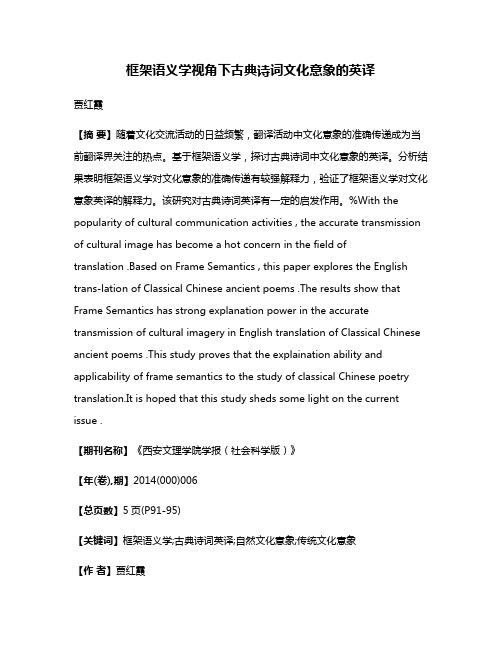
框架语义学视角下古典诗词文化意象的英译贾红霞【摘要】随着文化交流活动的日益频繁,翻译活动中文化意象的准确传递成为当前翻译界关注的热点。
基于框架语义学,探讨古典诗词中文化意象的英译。
分析结果表明框架语义学对文化意象的准确传递有较强解释力,验证了框架语义学对文化意象英译的解释力。
该研究对古典诗词英译有一定的启发作用。
%With the popularity of cultural communication activities , the accurate transmission of cultural image has become a hot concern in the field oftranslation .Based on Frame Semantics , this paper explores the English trans-lation of Classical Chinese ancient poems .The results show that Frame Semantics has strong explanation power in the accurate transmission of cultural imagery in English translation of Classical Chinese ancient poems .This study proves that the explaination ability and applicability of frame semantics to the study of classical Chinese poetry translation.It is hoped that this study sheds some light on the current issue .【期刊名称】《西安文理学院学报(社会科学版)》【年(卷),期】2014(000)006【总页数】5页(P91-95)【关键词】框架语义学;古典诗词英译;自然文化意象;传统文化意象【作者】贾红霞【作者单位】广州大学外国语学院,广州 510006【正文语种】中文【中图分类】H159翻译的文化转向已是翻译研究的一个新领域,被各国研究者接受。
认知脚本理论和汉语古诗词中动态事件的翻译
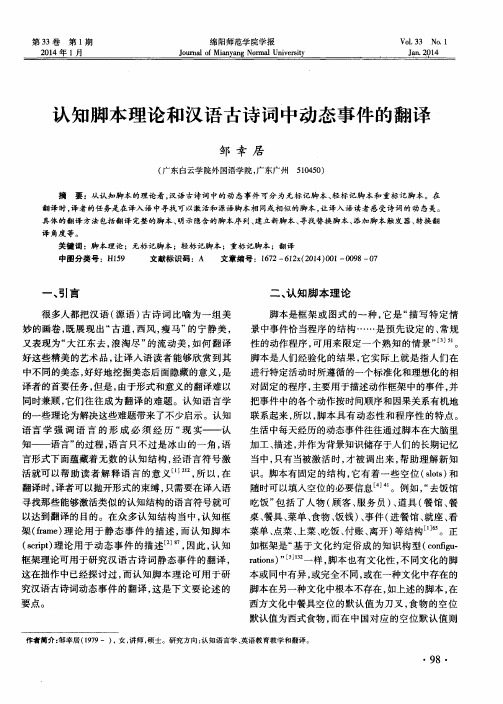
( s c r i p t ) 理论用于动态事 件的描述
, 因此 , 认知
框架理论可用于研究汉语古诗词静态事件 的翻译 , 这 在拙作 中 已经 探讨 过 , 而 认 知脚 本 理 论 可 用 于 研
邹 幸 居
( 广东 白云学院外 国语学 院 , 广东广州 摘 5 1 0 4 5 0 )
要 :从认 知脚 本的理论看 , 汉语 古诗词 中的动 态事件 可分为 无标记脚 本、 轻标记 脚本和 重标记脚 本。在
翻译 时, 译 者的任务是在译入语 中寻找 可以激 活和源语脚 本相 同或相似的脚本 , 让译入语读 者感 受诗 词的动 态美。
随时可以填入空位的必要信息 J 4 。例如 , “ 去饭馆 吃饭” 包 括了人物 ( 顾 客、 服务员 ) 、 道具 ( 餐馆 、 餐 桌、 餐具、 菜单 、 食物 、 饭钱 ) 、 事件( 进餐馆、 就座 、 看 菜单 、 点菜 、 上菜、 吃饭 、 付账 、 离开) 等结构 _ 1 J 6 。正
同 时兼顾 , 它 们 往往 成 为 翻译 的难 题 。认 知 语 言 学
对固定的程序 , 主要用于描述动作框架 中的事件 , 并
把 事件 中的各个 动作 按 时间顺 序和 因果关 系有 机地
的一些理论为解决这些难题带来了不少启示 。认知
语言学强调语 言的形成必须经历 “ 现 实— —认 知 —— 语 言 ” 的过 程 , 语 言 只不 过 是 冰 山 的一 角 , 语
脚本 中包括的所有事件都在古诗词 中出现 , 没有任
兰色姆“构架-肌质”理论视角下分析中国古诗翻译—以《题破山寺后禅院》为例
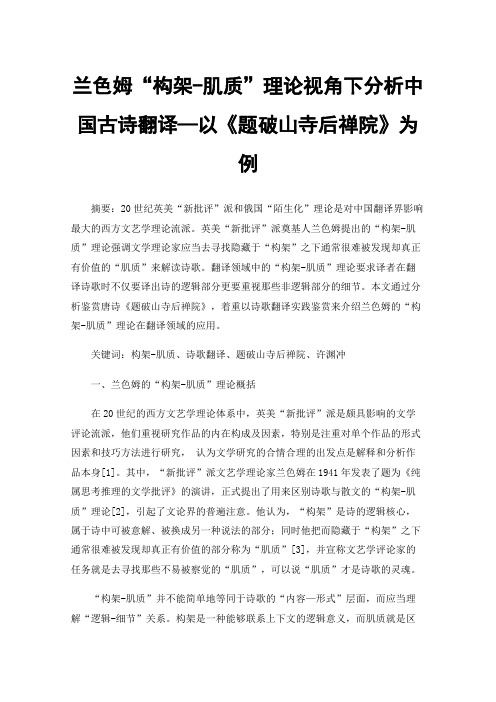
兰色姆“构架-肌质”理论视角下分析中国古诗翻译—以《题破山寺后禅院》为例摘要:20世纪英美“新批评”派和俄国“陌生化”理论是对中国翻译界影响最大的西方文艺学理论流派。
英美“新批评”派奠基人兰色姆提出的“构架-肌质”理论强调文学理论家应当去寻找隐藏于“构架”之下通常很难被发现却真正有价值的“肌质”来解读诗歌。
翻译领域中的“构架-肌质”理论要求译者在翻译诗歌时不仅要译出诗的逻辑部分更要重视那些非逻辑部分的细节。
本文通过分析鉴赏唐诗《题破山寺后禅院》,着重以诗歌翻译实践鉴赏来介绍兰色姆的“构架-肌质”理论在翻译领域的应用。
关键词:构架-肌质、诗歌翻译、题破山寺后禅院、许渊冲一、兰色姆的“构架-肌质”理论概括在20世纪的西方文艺学理论体系中,英美“新批评”派是颇具影响的文学评论流派,他们重视研究作品的内在构成及因素,特别是注重对单个作品的形式因素和技巧方法进行研究,认为文学研究的合情合理的出发点是解释和分析作品本身[1]。
其中,“新批评”派文艺学理论家兰色姆在1941年发表了题为《纯属思考推理的文学批评》的演讲,正式提出了用来区别诗歌与散文的“构架-肌质”理论[2],引起了文论界的普遍注意。
他认为,“构架”是诗的逻辑核心,属于诗中可被意解、被换成另一种说法的部分;同时他把而隐藏于“构架”之下通常很难被发现却真正有价值的部分称为“肌质”[3],并宣称文艺学评论家的任务就是去寻找那些不易被察觉的“肌质”,可以说“肌质”才是诗歌的灵魂。
“构架-肌质”并不能简单地等同于诗歌的“内容—形式”层面,而应当理解“逻辑-细节”关系。
构架是一种能够联系上下文的逻辑意义,而肌质就是区别于逻辑构架中不符合逻辑但更加精妙的部分。
对于诗歌翻译而言,我们不但要译出诗歌的“构架”,更要译出其“肌质”。
二、兰色姆“构架-肌质”理论视角下鉴赏唐诗《题破山寺后禅院》本文着重分析鉴赏唐诗《题破山寺后禅院》,作者为唐朝诗人常健,译文作品选取自国内诗歌翻译大师许渊冲老先生的译本。
《框架理论视角下汉英口译中文化负载词翻译策略研究》范文

《框架理论视角下汉英口译中文化负载词翻译策略研究》篇一一、引言在跨文化交流日益频繁的今天,口译作为文化传播的桥梁,承担着传递信息和语言转换的重要职责。
汉语和英语作为两种截然不同的语言体系,其间的文化负载词翻译显得尤为关键。
文化负载词承载着特定文化的独特信息,是语言中不可或缺的组成部分。
本文旨在从框架理论视角出发,探讨汉英口译中文化负载词的翻译策略。
二、框架理论概述框架理论是一种认知理论,它认为人们在理解外界事物时,会基于自身的认知框架来解读信息。
在翻译过程中,这种框架对于译者理解和传达原文的文化内涵具有重要意义。
文化负载词的翻译,不仅要求译者准确理解源语的文化内涵,还需要在目标语中寻找合适的表达方式,以实现文化的有效传递。
三、汉英口译中文化负载词的特点汉英口译中的文化负载词具有独特性、复杂性和敏感性。
这些词汇往往承载着深厚的文化底蕴,反映了特定文化的历史、习俗、价值观等。
在翻译过程中,这些词汇往往难以找到完全对应的英文表达,需要译者进行适当的处理和转化。
四、文化负载词的翻译策略1. 直译与意译相结合:对于一些具有明确文化内涵的词汇,可以采用直译的方式,保留其文化色彩。
同时,根据语境的需要,结合意译的方法,使译文更加流畅自然。
2. 借用法:当英语中没有完全对应的词汇时,可以借用其他词汇或短语来表达原意。
这种策略要求译者具备丰富的语言知识和灵活的思维能力。
3. 释义法:对于一些难以直译或借用的文化负载词,可以采用释义法,通过解释其含义来传达原文的信息。
这种方法可以帮助读者更好地理解原文的文化内涵。
4. 文化注释法:在某些情况下,为了保留原文的文化特色,可以在译文中加入适当的注释,解释文化背景和含义。
这种方法有助于增强读者对异文化的理解和接受。
五、实例分析以“龙”为例,在中国文化中,“龙”是吉祥、尊贵和力量的象征。
而在英语中,“dragon”则常被用来形容凶猛的怪物。
在汉英口译中,若直接将“龙”译为“dragon”,可能会造成误解。
古诗英译中的框架操作——以《望月怀远》四个英译本为例
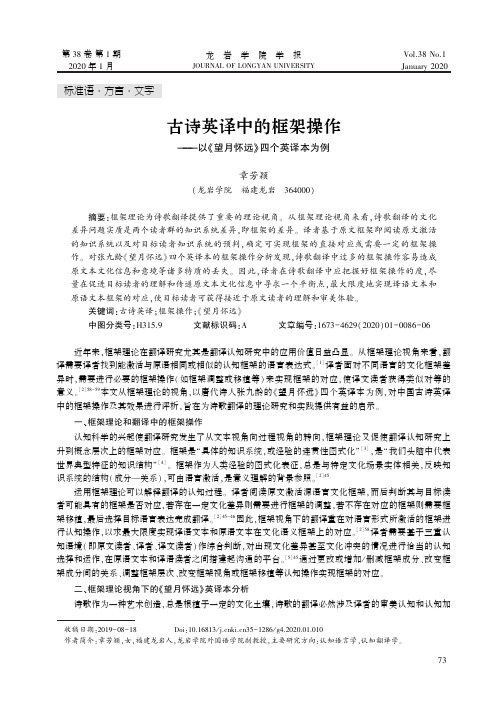
第38卷第1期2020年1月龙㊀岩㊀学㊀院㊀学㊀报JOURNALOFLONGYANUNIVERSITYVol.38No.1January2020标准语㊃方言㊃文字古诗英译中的框架操作以‘望月怀远“四个英译本为例章芳颖(龙岩学院㊀福建龙岩㊀364000)摘要:框架理论为诗歌翻译提供了重要的理论视角㊂从框架理论视角来看,诗歌翻译的文化差异问题实质是两个读者群的知识系统差异,即框架的差异㊂译者基于原文框架即阅读原文激活的知识系统以及对目标读者知识系统的预判,确定可实现框架的直接对应或需要一定的框架操作㊂对张九龄‘望月怀远“四个英译本的框架操作分析发现,诗歌翻译中过多的框架操作容易造成原文本文化信息和意境等诸多特质的丢失㊂因此,译者在诗歌翻译中应把握好框架操作的度,尽量在促进目标读者的理解和传递原文本文化信息中寻求一个平衡点,最大限度地实现译语文本和原语文本框架的对应,使目标读者可获得接近于原文读者的理解和审美体验㊂关键词:古诗英译;框架操作;‘望月怀远“中图分类号:H315.9文献标识码:A文章编号:1673-4629(2020)01-0086-06近年来,框架理论在翻译研究尤其是翻译认知研究中的应用价值日益凸显㊂从框架理论视角来看,翻译需要译者找到能激活与原语相同或相似的认知框架的语言表达式㊂[1]译者面对不同语言的文化框架差异时,需要进行必要的框架操作(如框架调整或移植等)来实现框架的对应,使译文读者获得类似对等的意义㊂[2]58-59本文从框架理论的视角,以唐代诗人张九龄的‘望月怀远“四个英译本为例,对中国古诗英译中的框架操作及其效果进行评析,旨在为诗歌翻译的理论研究和实践提供有益的启示㊂一㊁框架理论和翻译中的框架操作认知科学的兴起使翻译研究发生了从文本视角向过程视角的转向,框架理论又促使翻译认知研究上升到概念层次上的框架对应㊂框架是 具体的知识系统,或经验的连贯性图式化 [3],是 我们头脑中代表世界典型特征的知识结构 [4]㊂框架作为人类经验的图式化表征,总是与特定文化场景实体相关,反映知识系统的结构(成分 关系),可由语言激活,是意义理解的背景参照㊂[2]45运用框架理论可以解释翻译的认知过程㊂译者阅读原文激活源语言文化框架,而后判断其与目标读者可能具有的框架是否对应,若存在一定文化差异则需要进行框架的调整,若不存在对应的框架则需要框架移植,最后选择目标语言表达完成翻译㊂[2]45-46因此,框架视角下的翻译重在对语言形式所激活的框架进行认知操作,以求最大限度实现译语文本和原语文本在文化语义框架上的对应㊂[2]58译者需要基于三重认知语境(即原文读者㊁译者㊁译文读者)作综合判断,对出现文化差异甚至文化冲突的情况进行恰当的认知选择和运作,在原语文本和译语读者之间搭建起沟通的平台㊂[5]45通过更改或增加/删减框架成分㊁改变框架成分间的关系㊁调整框架层次㊁改变框架视角或框架移植等认知操作实现框架的对应㊂二㊁框架理论视角下的‘望月怀远“英译本分析诗歌作为一种艺术创造,总是根植于一定的文化土壤,诗歌的翻译必然涉及译者的审美认知和认知加㊀收稿日期:2019-08-18㊀㊀㊀㊀㊀Doi:10.16813/j.cnki.cn35-1286/g4.2020.01.010作者简介:章芳颖,女,福建龙岩人,龙岩学院外国语学院副教授,主要研究方向:认知语言学,认知翻译学㊂工过程(即框架操作)㊂让处于另一种文化语境的目标读者从译文中获得类似原文读者的理解和审美体验应当是诗歌翻译追求的目标㊂笔者拟从框架理论视角评析张九龄‘望月怀远“英译本的框架操作㊂‘望月怀远“描写了诗人月圆之夜的思亲之情,语言质朴但意境幽深,情感真挚深沉,是中国古代借月抒情诗歌的名篇㊂原诗如下:望月怀远(张九龄)海上生明月,天涯共此时㊂情人怨遥夜,竟夕起相思㊂灭烛怜光满,披衣觉露滋㊂不堪盈手赠,还寝梦佳期㊂本文选取四位中外翻译家弗莱彻(W.J.B.Fletcher),威特㊃宾纳(WitterBynner),许渊冲以及丁祖馨的译本从框架操作角度作对比分析(以下分别简称弗译㊁宾译㊁许译和丁译)㊂总的来看,四位译者均对原诗进行了框架成分增删或更改㊁框架关系改换等的框架操作㊂(一)标题英译中的框架操作四个译本标题英译的框架操作情况如表1所示㊂表1㊀‘望月怀远“标题英译中的框架操作原文框架译本操作情况㊀㊀译文框架英译表达望月弗译成分删减月Moon宾译无望月LookingattheMoon许译无望月LookingattheMoon丁译关系改换在月夜OnaMoonlightNight怀远弗译成分删减和更换想法Thoughts宾译无怀远ThinkingofOneFarAway许译无怀远longingforonefaraway丁译成分更换想起远方至爱ThinkingofMyFarawayLove从表1可以看出,宾译和许译均以直接对应的方式保留原标题框架,弗译和丁译均有框架操作㊂由于中西方都有将情感寄托于 月 的类似体验,宾译和许译以框架对应的方式翻译不影响译文读者获得类似的意义理解;弗译将 望月 译为 月 , 怀远 更改为 想法 ,且删去 怀念 的客体即 远方的人 ,大大增加了标题的解读空间,可能会激活读者超出原框架的各种遐想;丁译将 望月 背景化为 在月夜 ,使框架关系由并列变为从属,此外, 怀远 的 远 具体化为 爱人/恋人 ,与原框架不符㊂实际上,结合张九龄这首诗的创作时间和背景, 怀远 当指怀念远方的亲人, 远 应为其远在家乡韶州的年迈母亲㊂[6](二)首联英译中的框架操作四个译文首联英译的框架操作情况分别如表2㊁表3所示㊂表2㊀ 海上生明月 英译中的框架操作译本操作情况㊀㊀㊀㊀译文框架㊀㊀㊀英译表达弗译成分更换新生的明月从海上升起Theclearmoonuprises,new-bornfromthesea.宾译成分删减㊁更换月亮此刻在海面上变圆Themoon,grownfullnowoverthesea.许译无海上生明月Overtheseagrowsthemoonbright.丁译成分删减㊁更换月亮从海上升起Themooncomesuponthesea㊀㊀首联上句 海上生明月 ,诗人用 生 字形象地写出了明月从海面上冉冉升起的情景㊂从表2看出,弗译㊁宾译和丁译对 生 的翻译均涉及一定的框架操作,或更换框架成分,将 生 译为 升起 ,或删减之,均造成原诗艺术效果大打折扣;而许译将 生 字直译为 grow ,保留原诗的拟人化手法,形象再现了原诗的意象㊂对 明月 的处理,宾译更换为 满月 ,丁译删去 明月 的特征 明 ㊂古代汉语中, 望月 指 夏历每月十五的月亮 [7]1947,故此处 明月 即 满月 ,寓意 团圆 ,可诗人却不能与家人团圆,更突显其思亲之情㊂可见, 明 字在翻译中必须予以体现,否则意境大为丢失㊂[8]从这点看,弗译和许译采用直译是可取的,而宾译的 满月 更有效地传递了中国的 月 文化,实现了译文和原文在文化框架上的对应㊂表3㊀ 天涯共此时 英译中的框架操作译本操作情况译文框架英译表达弗译无即使在天涯都处在同一时间Thishouristhesamethroughthebourneoftheskies.宾译成分更换/增加(月亮)照亮了整个天堂Brighteningthewholeofheaven.许译成分增加我们在相隔遥远的地方凝望着它Wegazeonitfar,farapart.丁译成分更换/增加月亮在空中闪耀,照着(东西)大地Itshinesinthesky,eastandwest.天涯共此时 紧接上句 海上生明月 ,表面上写此时各地都在共享这皎洁月光,实则以 共 字激活了天各一方的人此时仰望圆月互相思念的场景㊂没有明写怀,而怀得更深㊂[9]弗译在语言形式上与原文对等,但框架上并不对应,无法在目标读者中激活思念的场景㊂宾译和丁译将 (此时)明月照耀 显化,但无法激活思念的场景,未能实现与原诗框架的对应,且宾译将 天涯 更换为西方特有的文化负载词 天堂 ,当属误译㊂许译显化了原框架的主体(我们)以及 凝望 动作,成功再现了诗人与远方的亲人望月思念对方的场景,实现了与原框架的对接㊂(三)颔联英译中的框架操作四个译文颔联英译的框架操作情况分别如表4㊁表5所示㊂表4㊀ 情人怨遥夜 英译中的框架操作译本操作情况译文框架英译表达弗译成分更换夜晚,我的爱人因远离我而悲伤Withnightmylovegrievestobesofarfromme.宾译成分删减㊁框架转喻给分离的心带来的是Bringstoseparatedhearts许译无恋人们埋怨漫漫长夜Loverscomplainoflong,longnight;丁译成分更换㊁增加夜晚,我的爱人思念我,无法入睡Atnightmylovemissesme,unabletosleep.表5㊀ 竟夕起相思 英译中的框架操作译本操作情况㊀㊀译文框架英译表达弗译成分更换随着夜幕降临,我们渴望(相见)Aseveningapproaches,ourlongingsarises.宾译无夜里长久的沉思Thelongthoughtfulnessofnight.许译成分删减他们不眠相思Theyriseandlongforthedearheart.丁译成分更换在夜晚,我们相思,渴望相见Atnightlovesickwelongtomeet.颔联紧承首联,由 望月 而 怀远 ,意为多情的人怨恨月夜漫长,整夜不眠想念亲人㊂诗的主题是怀念远方亲人,故诗中的 情人 应是思念亲人之人,至于是指诗人自己还是指远方的亲人,诗人没有明说㊂从表4看出,弗译㊁许译和丁译将 情人 译为 恋人/爱人 ,当属误译㊂宾译运用转喻性框架操作,以 分离的心 转指 分离的人 ,成功激活 思念 框架,且保留了原诗指称上的模糊性,留待读者去解读,但 怨遥夜 删去不译,对主题表达造成一定损失㊂弗译将 怨 改为 悲伤 ,与原诗所要表达的无法与亲人团聚而心烦意乱以致埋怨的心境不相匹配;丁译更换为 思念我 ,表达更加直白,但丢失了原诗的 因思而怨 ,削弱了表达力度;许译的 埋怨 则激活了诗人因思亲而烦躁的心境,与原框架相符㊂此外,从表5看出,弗译和丁译将 竟夕 更改为 随着夜幕降临 , 在夜晚 ,大大削弱了主题㊂可见,译者对原框架成分不恰当的改换或删减都可能造成对原诗主题表达的削弱㊂(四)颈联英译中的框架操作颈联 灭烛怜光满,披衣觉露滋 描写诗人深夜久立望月的场景㊂他吹灭蜡烛,让皎洁月光充满卧室,表面写对月色的怜爱,实质是对家人的怜爱;后来他 披衣 出屋犹感 露滋 ,透露出诗人伫立望月之久,怀远情之深沉㊂如表6㊁表7所示,弗译删去 灭烛怜光满 这一烘托主题意境的细节描写,是对主题表达的一大损失,下句增加了隐含成分 到户外 ,但 披衣 以及 觉露滋 等细节均删去,仅保留 露水 及其特征 多 ;宾译保留了原框架的 灭烛 和 披衣 ,但 怜光满 觉露滋 更换为 不会更暗淡 没有更暖和 ㊂以上对原框架诸多细节过多的删减和不恰当的改换,大大削弱了主题,无法形象再现原诗的场景和意境㊂丁译以 不能浪费月光 解释 灭烛 之原因,间接表达诗人对月光的怜爱,以月光寄托其思母之情;下句同弗译,将隐含成分 到户外 显化,有助于读者的理解,但将伫立望月之久而 觉露滋 描绘成诗人深夜披衣到户外看露珠,意境全然不同㊂许译上句虽未直译出 怜 ,却以 灭烛光更满 激活了月光充满卧室的画面,间接抒发了诗人对满屋月光的欣喜和怜爱,下句以直接对应的方式译出了诗人(因深夜久立)露水沾湿衣裳的情景,原诗场景在译文中得到形象再现㊂表6㊀ 灭烛怜光满 英译中的框架操作译本操作情况译文框架英译表达弗译删译无无宾译成分更换灭烛却不会更暗淡ItisnodarkerthoughIblowoutmycandle.许译成分删减灭烛光更满Candleblownout,fullerislight;丁译成分增删灭烛,不能浪费月光Isnuffoutthecandle,Icannotwastemoonlight.表7㊀ 披衣觉露滋 英译中的框架操作译本操作情况㊀㊀译文框架英译表达弗译成分增删到户外发现露水多AndoutsideIfind,ah!Howrichisthisdew.宾译成分更换披衣却没有更暖和ItisnowarmerthoughIputonmycoat.许译无披衣(仍觉)身上沾满露水Mycoatputon,I mmoistwithdew.丁译成分增加㊁更换披衣到户外看露珠Wearingmyrobe,Iwalkoutside,watchingthesparklingdew.(五)尾联英译中的框架操作尾联 不堪盈手赠,还寝梦佳期 ,意为月华虽好但不能相赠,不如回入梦乡觅取佳期,进一步抒发了对远方亲人的一片深情㊂四个译文框架操作情况如表8㊁表9㊂表8㊀ 不堪盈手赠 英译中的框架操作译本操作情况㊀㊀译文框架英译表达弗译无不能将月色捧给你Unableinhandfulstogiveittoyou宾译成分更换因此我给月亮留了言SoIleavemymessagewiththemoon许译无不能将月色捧给你AsIcan thandyoumoonbeamswhite,丁译无不能将月色捧给你Oh,couldIbringyouahandfulofmoonlightSoyoucansharetheview?No,no:impossible.表9㊀ 还寝梦佳期 英译中的框架操作译本操作情况㊀㊀译文框架英译表达弗译成分更换㊁框架转喻我度过漫漫长夜,在梦中甜蜜相聚IndreamofsweetmeetingsIpassthelongnight宾译成分删减就寝希望做梦Andturntomybed,hopingfordreams.许译框架转喻就寝希望梦见你Igotobedtodreamofyou.丁译成分增删独自就寝希望有美梦Iwillgobacktobed,alone,andtrytofindasweetdream,hereinmyroom.从表8可以看出,弗译㊁许译㊁丁译均以框架直接对应的方式直抒诗人无法与亲人团聚的惆怅,丁译更是以问答形式细腻地还原诗人寄思念于月光,却无法将月光相赠的惆怅心理㊂宾译对原诗的更改却使诗人的惆怅心理无从体现㊂此外,如表9所示,四个译本对 梦佳期 的处理各不相同㊂ 佳期 常指恋人约会相聚的日期,‘辞海“中解释为 好时光 ,结合本诗主题,此处 佳期 当指与亲人相聚的美好时光㊂弗译和许译均运用了转喻性框架操作,以同一框架内的一成分转指另一成分,弗译以 梦相聚 代 梦佳期 ,不亚于原诗表达效果;许译将 梦佳期 更换为 梦见你 ,更直接抒发了诗人的怀远之情;宾译和丁译均删去梦 的内容,即 佳期 ,一定程度上增加了读者的认知负担㊂对比而言,弗译和许译对 梦佳期 的框架操作较好地实现了框架的对应㊂三、结语本文从框架理论视角评析‘望月怀远“四个英译本的框架操作㊂四个译本可谓各有千秋,但也有瑕疵㊂如,该诗主题是 望月思亲 ,而弗译㊁许译和丁译的 mylove/lovers 激活的是 爱情 框架,造成与主题框架的不对应㊂当然,撇开这一点,总体来看,许译对原文本框架保留最多,涉及的框架操作较少,成功再现了原诗的画面和意境,使目标读者得以获得接近原文读者的理解和审美体验㊂许渊冲主张译诗要传达原诗的意美㊁音美和形美㊂因此,在原框架与目标框架文化差异较小的情况下他尽可能以直接对应的方式翻译,尽可能保留原文本框架,以传达原诗的 意美 ;此外,从文本类型来看,许译保留原文的诗行数量,且分别在一三五七行㊁二四行㊁六八行押韵,以英文韵体诗的形式对应这首五言律诗,努力做到了音美和形美㊂相比之下,弗译㊁宾译和丁译对原文本框架改动较多,如弗译和丁译在标题上相比原框架作了较大改动;对 天涯共此时 的翻译,三个译本均无法传达其真正内涵,译文框架与原文框架不符;对 怨 竟夕 灭烛怜光满,披衣觉露滋 等烘托诗人 怀远 深情的细节描写在三个译文中或更换成分,或删去不译,使原诗的 意美 大打折扣㊂当然,从文本类型来看,三个译本均为诗体形式,诗形上与原诗是对应的,弗译还以ababcc形式押韵,宾译和丁译为散体诗形式;但在诗行数量上,弗译和丁译与原诗不一致㊂诗歌翻译作为跨语言的艺术再创造,必然涉及译者的审美认知和认知加工过程㊂译者的翻译过程实质上是在概念层次上进行认知操作的过程,而不仅仅是语言形式的转换㊂[2]150从框架视角来看,当原文本在原语读者中激活的框架与译文读者存在文化框架的差异时,译者需要通过框架认知操作来实现译语文本和原语文本在框架上的对接,使目标读者从译文中获得尽量接近原语读者的阅读体验㊂但本文对古诗英译中译者框架操作的分析发现,过多的框架操作易造成原文本文化信息和意境等多方面特质的丢失㊂中国古诗英译需要译者把握好框架操作的度,兼顾原语文化传播和译文读者的可接受度,以求在译诗中再现中国古诗的魅力㊂参考文献:[1]汪立荣.从框架理论看翻译[J].中国翻译,2005(3):27-32.[2]肖开容.诗歌翻译中的框架操作:中国古诗英译认知研究[M].北京:科学出版社,2017:45-150.[3]FILLMOREC.Framesandthesemanticsofunderstanding[J].QuadernidiSemantics,1985(6):222-254.[4]BEDNAREKM.Framesrevisited thecoherence-inducingfunctionofframes[J].JournalofPragmatics,2005(37):685-705.[5]王明树. 主观化对等 对原语文本理解和翻译的制约[M].汕头:汕头大学出版社,2010:45.[6]杨贵章,钟泽楠. 语境参数理论"视角下的诗歌英译研究 张九龄‘望月怀远“之意美阐释[J].金华职业技术学院学报,2014(4):73-77.[7]夏征农,陈至立.辞海[Z].上海:上海辞书出版社,2010:1947.[8]冯霞.翻译层次论视角下的诗歌翻译评析 以‘望月怀远“两个法译本为例[J].长春教育学院学报,2018(5):37-39.[9]郑孟彤.从张九龄的‘望月怀远“诗谈起[J].岭南文史,1997(1):62-64.责任编辑:江清悠FrameOperationin4VersionsofEnglishTranslationoftheClassicalChinesePoemLookingattheMoonandThinkingofOneFarAwayZHANGFangying(LongyanUniversity,Longyan,Fujian364000,China)Abstract:TheFrameTheoryprovidesanimportanttheoreticalperspectiveforpoetrytranslation.Fromtheperspectiveofframetheory,theculturaldifferencesinpoetrytranslationarefactuallythedifferencesoftworeadergroups knowledgesystems,i.e.differencesofframes.Basedontheoriginalframe(i.e.theknowledgesystemstimulatedbythesourcetext)andtargetreaders knowledgesystem,translatorsdeterminewhethertheycanachievedirectcorrespondenceofframesorneedframeoperation.ThroughananalysisofframeoperationinfourEnglishtranslationsofZhangJiuling sLookingattheMoonandThinkingofOneFarAway,thispapertriestoconcludethattoomuchframeoperationinpoetrytranslationmaycausethelossofculturalinformationandthebeautyofpoeticimageryofthesourcetext.Therefore,itsuggeststhatpoetrytranslatorsshouldseekabalancebetweenpromotingtargetreaders understandingandconveyingtheculturalinformationofthesourcetext,toachievetotheutmostextentthecorrespondenceoftheoriginalframeandthetargetframe,sothattargetreaderscangetanunderstandingandaestheticexperiencesimilartothatofsource-textreaders.Keywords:EnglishtranslationofclassicalChinesepoetry;frameoperation;LookingattheMoonandThinkingofOneFarAway。
框架理论在翻译教学中的应用
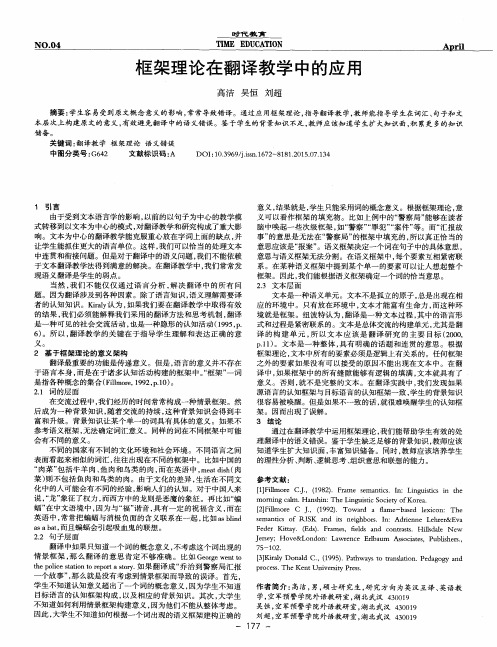
墼 !
No. O 4
TI ME EDUCATI ON
框 架 理 论在 翻 译 教 学 中 的应 用
高洁 吴 恒 刘 超
摘要 : 学生容 易受到原文概念 意义的影响 , 常常导致错译 。通过应用框 架理论 , 指导翻译教 学, 教师能指导 学生在词 汇、 句子和文 本层次上构 建原 文的意义 , 有效避免翻译 中的语 义错误 。鉴 于学生的背景 知识 不足 , 教 师应该知道 学生扩 大知识 面, 积 累更 多的知识
“ 肉菜 ” 包括 牛羊 肉 、 鱼 肉和 鸟类 的肉 , 而在英语 中 , me a t d i s h ( 肉 菜) 则不包 括鱼 肉和鸟类 的肉。 由于文化 的差异 , 生 活在 不同文 参 考 文 献 : 化 中的人 可能会有 不同的经验 , 影 响人 们的认知 。对于 中国人来 [ 1 ] F i l l mo r e c . J . ,( 1 9 8 2 ) .F r a me s e ma n t i c s .I n :L i n g u i s t i c s i n t h e 说, “ 龙” 象征 了权力 , 而西方中的龙则是恶魔 的象征 。再 比如“ 蝙 m or ni ng c a l m .H a ns h i n: The Li ng u i s t i c Soc i e t y o f Ko r e a 蝠” 在 中文 语境 中 , 因为 与“ 福” 谐音 , 具有 一定 的祝 福含义 , 而在 [ 2 ] F i U mo r e C J . ,( 1 9 9 2 ) .T o wa r d a l f a me - b a s e d l e x i c o n :T h e 英语 中 , 常 常把 蝙蝠与消极负 面的含义联系在 一起 , 比如 a s b l i n d s e ma n t i c s o f RI S K a n d i t s n e i g h b o r s .I n :Ad r i e n n e L e h r e r &E v a a s a b a t , 而且 蝙蝠会 引起 吸血鬼的联想 。 F e d e r Ki t t a y .( E d s ) .F r a me s ,f i e l d s a M c o n t r a s t s .Hi U s d a l e Ne w 2 . 2 句子层面 J e r s e y ;Ho v e & L o n d o n :L a wr e n c e E r l b a u m A s s o c i a t e s ,P u b l i s h e r s . , 翻译 中如果 只知道 一个 词的概念意义 , 不考 虑这个词 出现 的 7 5—1 0 2. 情景 框架 , 那么 翻译 的意 思肯 定不 够准 确 。 比如 G e o r g e w e n t t o 【 3 ] K i r a l y Do n a l d C. , ( 1 9 9 5 ) . P a t h wa y s t o t r a n s l a t i o n . P e d a g o g y a n d t h e p o l i c e s t a t i o n t o r e p o r t a s t o r y . 如果 翻译 成 “ 乔治 到警察局 汇报 p r o c e s s . The Ke n t U ni ve r s i t y Pr e s s . 个故事 ” , 那 么就是没有考 虑到情景框架而导致 的误译 。首先 , 学生不知道认知意义超 出了一个 词的概念意义 , 因为学生不知道 作者 简介 : 高洁 , 男, 硕士研 究 生, 研 究方 向为英汉互 译、 英语教 目标语 言的认知框架 构成 , 以及相应 的背景知 识。其次 , 大学 生 学, 空军预警 学院外语教研 室, 湖北武汉 4 3 0 0 1 9 不知道如何利用情景框架构建意义 , 因为他们不能从整体考虑 。 吴恒 , 空军预警 学院外语教研 室, 湖北武汉 4 3 0 0 1 9 因此 , 大学生不 知道 如何 根据一个词出现的语义框架建构正确 的 刘超 , 空军预警 学院外语教研 室, 湖北武汉 4 3 0 0 1 9
框架语义学视角下古典诗词文化意象的英译
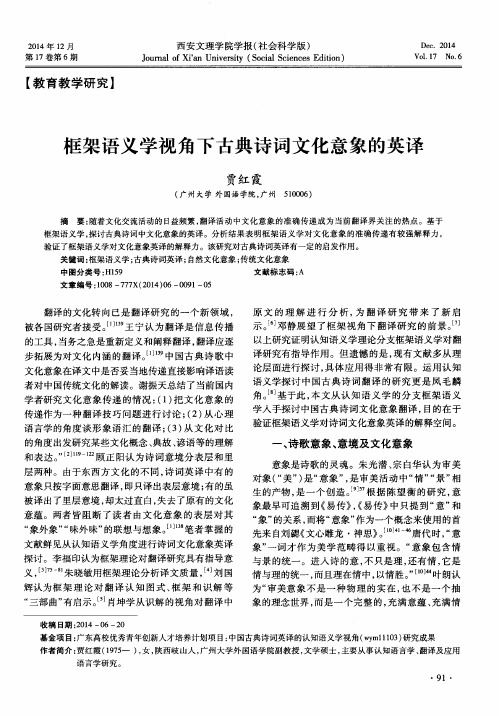
框架语 义学 , 探 讨古典诗词 中文化意象 的英译 。分 析结果 表 明框架语 义学对 文化 意象 的准确传 递有较 强解释力 , 验证了框架语义学对文化 意象英译 的解释力 。该研究对古 典诗词英译有一定 的启发作用 。 关键词 : 框 架语 义学 ; 古典诗词 英译 ; 自然 文化意象 ; 传 统文化意象
探 讨 。李 福 印认 为框架 理 论对 翻译 研究 具有 指 导意 义, _ 3 J 巧 朱 晓敏 用 框架 理论 分 析译 文 质 量 , 4 刘 国
、
诗 歌意象 、 意境及文化意 象
意 象是 诗歌 的灵 魂 。朱 光 潜 、 宗 白华 认 为 审 美 对象( “ 美” ) 是“ 意象” , 是 审美 活 动 中“ 情” “ 景” 相 生 的产 物 , 是一个创造 。 9 』 5 根 据 陈 望衡 的 研 究 , 意
2 0 1 4年 1 2月
第 1 7卷 第 6期
西安 文理 学 院学 报 ( 社 会科 学 版 ) J o u na r l o f X i ’ a n U n i v e r s i t y( S o c i a l S c i e n c e s E d i t i o n )
与景 的统 一 。进 入 诗 的 意 , 不 只是 理 , 还有情 , 它是 情与 理 的统一 , 而 且理 在情 中 , 以情 胜 。 ” _ l o J “叶朗认 为“ 审美 意 象 不 是 一 种 物 理 的 实 在 , 也 不 是 一 个 抽
辉认为框架 理论对 翻译认 知 图式 、 框 架 和 识 解 等 “ 三部 曲 ” 有启示 。 _ 5 肖坤 学从 识 解 的视 角 对 翻译 中
一
者对中国传统文化的解读 。谢振天总结了当前国内 学者研究文化 意象 传递的情况 : ( 1 ) 把文化 意象 的
框架语义学视角下古诗词翻译研究——以《石灰吟》为例
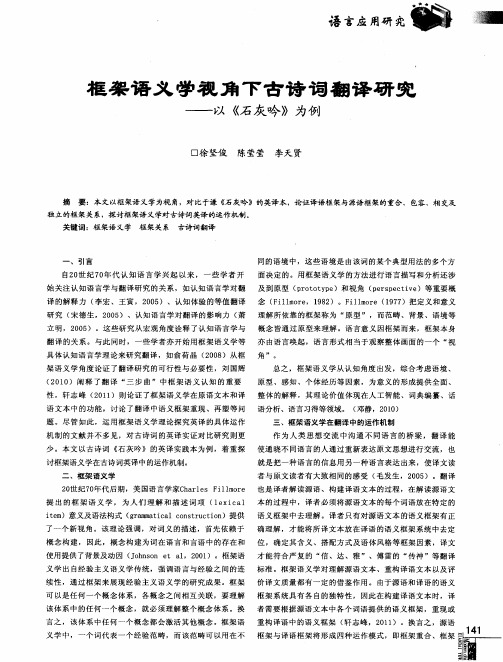
框架 语 义 学视 角下古诗 词翻译研 究
以 石 灰 吟 为 例
口徐 坚俊
陈 莹莹
李 天 贤
摘
要 :本文以框架语义学为视 角,对 比于谦 《 石灰吟》 的英译本 ,论证译语框架与源语框 架的重合 、包容 、相 交及
框架关系 古诗词翻译
独立的框架关系,探讨框架语义学对 古诗词英译 的运作机制 。
译 的解释 力 ( 李宏 、王寅 ,2 0 0 5 )、认知 体验 的等值翻译 念 ( F i l l m o r e ,1 9 8 2 ) 。F i l i m o r e( 1 9 7 7 )把 定 义 和 意 义
研究 ( 宋 德 生 ,2 0 0 5 )、认知语 言学对翻译 的影响力 ( 萧 理 解 所 依 靠 的框 架 称 为 “ 原 型 ” , 而 范 畴 、背 景 、 语 境 等
了一个 新视角 。该理论 强调 ,对 词义 的描述 ,首先 依赖 于 确理解 ,才能将所译 文本放在 译语 的语义框 架系统 中去 定
概 念 构 建 , 因此 , 概 念 构 建 为 词 在 语 言 和 言 语 中 的存 在 和 位 ,确 定 其 含 义 、 搭 配 方 式 及 语 体 风 格 等 框 架 因素 , 译 文 使用 提供 了背 景及 动 因 ( J o h n s o n e t a l ,2 0 0 1 ) 。框 架 语 才 能 符 合 严 复 的 “ 信 、 达 、雅 ”、 傅 雷 的 “ 传 神 ”等 翻 译 义 学 出 自经 验 主 义 语 义 学 传 统 ,强 调 语 言 与 经 验 之 间 的 连 标 准 。框 架 语 义 学 对 理 解 源 语 文 本 、重 构 译 语 文 本 以及 评
立 明 ,2 0 0 5 )。这些研 究从宏观角度 诠释 了认 知语言学与 概 念 皆 通 过 原 型 来 理 解 。 语 言 意 义 因 框 架 而 来 , 框 架 本 身 翻 译的关 系 。与此 同时 ,一 些学者亦 开始用框 架语义学等 亦 由语言唤起 ,语言形式 相当于观 察整体画面 的一个 “ 视 具体 认知语 言学理论来研 究翻译 ,如 俞荷 晶 ( 2 0 0 8 )从框 角 ” 。
框架理论对古诗英译的启示
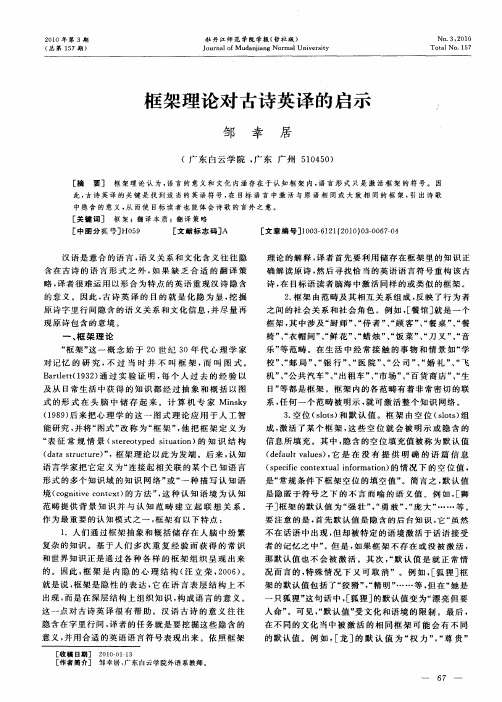
确 解 读 原 诗 , 后 寻找 恰 当 的英 语语 言 符 号 重 构 该 古 然 诗 , 目标 语 读 者 脑 海 中激 活 同样 的或 类 似 的 框 架 。 在 2 框 架 由范 畴 及 其 相 互 关 系 组 成 , 映 了 行 为 者 . 反
作 为 最 重 要 的认 知 模 式 之 一 , 架 有 以下 特 点 : 框
子 ] 架 的 默认 值 为 “ 壮 ” “ 敢 ” “ 大 ” … 等 。 框 强 ,勇 ,庞 …
要 注意 的是 , 先 默认 值 是 隐 含 的 后 台 知 识 , “ 然 首 它 虽
框 架 理 论 对 古 诗 英 译 的 启示
邹 幸 居
(广东 白云 学 院 , 广东 广州 5 0 5 ) 1 4 0
[ 摘 要 ] 框 架 理 论 认 为 , 言 的 意义 和 文 化 内 涵 存 在 于 认 知 框 架 内 , 言 形 式 只是 激 活 框 架 的 符 号 。 因 语 语
21 0 0年 第 3 期 ( 第 1 7期 ) 总 5
牡 丹 江 师 范 学 院 学报 ( 哲社 版 )
J ur a fM u a j n r a ie st o n l d i gNo m lUnv riy o na
N O 3. 0 0 . 2 1
To a . 5 t1 NO 1 7
( 9 9 后来 把 心 理 学 的 这 一 图 式 理 论 应 用 于 人 工 智 18)
机 ” “ 共 汽车 ” “ 、公 、 出租 车 ” “ 场 ” “ 货 商 店 ” “ 、市 、百 、 生 日” 都 是 框 架 。框 架 内 的各 范 畴 有 着 非 常 密 切 的联 等 系 , 何 一 个 范畴 被 明示 , 可 激 活 整 个 知 识 网 络 。 任 就 3 空 位 ( lt) 默 认 值 。框 架 由 空 位 ( lt) . sos 和 sos 组
《框架理论视角下汉英口译中文化负载词翻译策略研究》范文
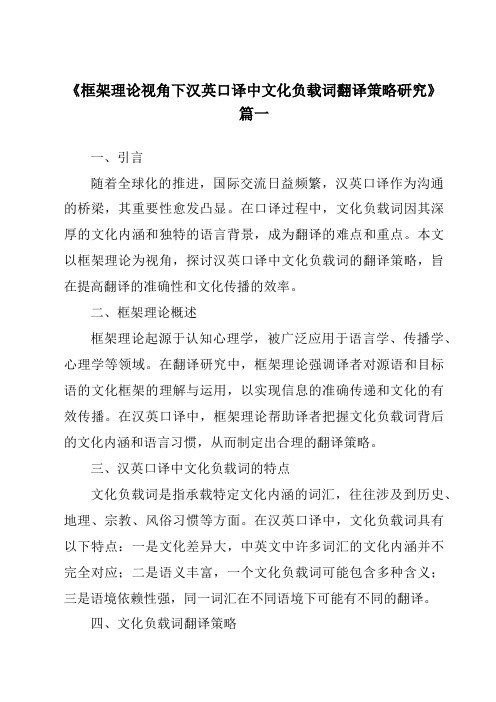
《框架理论视角下汉英口译中文化负载词翻译策略研究》篇一一、引言随着全球化的推进,国际交流日益频繁,汉英口译作为沟通的桥梁,其重要性愈发凸显。
在口译过程中,文化负载词因其深厚的文化内涵和独特的语言背景,成为翻译的难点和重点。
本文以框架理论为视角,探讨汉英口译中文化负载词的翻译策略,旨在提高翻译的准确性和文化传播的效率。
二、框架理论概述框架理论起源于认知心理学,被广泛应用于语言学、传播学、心理学等领域。
在翻译研究中,框架理论强调译者对源语和目标语的文化框架的理解与运用,以实现信息的准确传递和文化的有效传播。
在汉英口译中,框架理论帮助译者把握文化负载词背后的文化内涵和语言习惯,从而制定出合理的翻译策略。
三、汉英口译中文化负载词的特点文化负载词是指承载特定文化内涵的词汇,往往涉及到历史、地理、宗教、风俗习惯等方面。
在汉英口译中,文化负载词具有以下特点:一是文化差异大,中英文中许多词汇的文化内涵并不完全对应;二是语义丰富,一个文化负载词可能包含多种含义;三是语境依赖性强,同一词汇在不同语境下可能有不同的翻译。
四、文化负载词翻译策略(一)直译加注策略直译加注策略是指在保留原词汇基本意义的基础上,对其中包含的文化内涵进行解释或补充说明。
这种方法可以较好地传递原文的文化信息,帮助目标语听众理解文化背景。
例如,“中国红”可翻译为“Chinese red (a symbol of good luck and prosperity)”。
(二)意译策略意译策略是指根据原文的语义和精神,用目标语重新表达原词的意思。
这种方法适用于那些在目标语中找不到完全对应词汇的情况。
例如,“龙”在中文中常被视为吉祥、权力的象征,而在英文中则更多指代“dragon”,但并不完全涵盖其文化内涵,此时可译为“the Chinese sign of auspiciousness and power”。
(三)借词策略借词策略是指直接将源语中的词汇借用为目标语中的新词汇。
框架理论下的唐诗经典翻译研究

框架理论下的唐诗经典翻译研究作者:项君玲徐坚俊来源:《现代语文》2018年第09期摘要:本文以框架理论为基础,结合唐诗《静夜思》及其德译本,探讨原文与译文的框架互动与转换机制,以期拓展认知语言学在翻译中的适用范围。
研究发现:原文框架与译文框架存在框架保留、框架嵌入以及框架置换三种语义框架互动模式;由于原文作者与译者之间存在文化背景和类型学差异,原文框架与译文框架之间多呈现嵌入与置换框架模式;作为汉语经典外宣的重要途径,把握唐诗的意合特征是提高译文品质、保留中国汉语文化特色的关键。
关键词:框架理论唐诗翻译认知模式一、引言自20世纪80年代以来,框架理论(Fillmore,1982、1985)得到了蓬勃发展,并不断拓展其研究领域,与多个学科形成交叉。
很多语言学家认为,翻译活动源于译者心理空间与外部客观世界的互动体验,翻译研究应更多侧重内在深层的认知解读(Martin,2010;王寅,2005;卢卫中、王福祥,2013;颜林海,2014;金胜昔、林正军,2016;马星城,2017)。
框架理论为翻译研究的理论和实践注入了鲜活的生命力。
框架理论之所以适用于翻译研究,不仅是因为它所具有的独到的语言研究视角和方法,还“综合考虑语境、原型、感知、个体经历等因素,为意义的形成提供了全面、完善的解释”(邓静,2010:66)。
目前,框架语义学对翻译研究的解释在相关文献中已有详述(Snell-Hornby,1988;Ammann,1990;Neubert & Shreve,1992;王岫庐、王东风,2016;马珊,2018)。
尽管如此,运用框架理论探究翻译的具体运作机制的论著并不多见,对唐诗经典翻译的实证比较研究则更为罕见。
本文以唐诗经典《静夜思》的德译本为例,着重探讨框架理论在古典诗词翻译中的认知机制。
二、框架理论概要20世纪80年代初,框架理论由Charles Fillmore首先提出,它遵循了经验主义语义学传统,继承了Fillmore在词汇语言学方面的研究成果,并拓展到了认知领域,强调语言与经验之间的连续性,通过框架来展现经验主义语义学的研究成绩。
视觉化框架下宋词词牌名英译研究
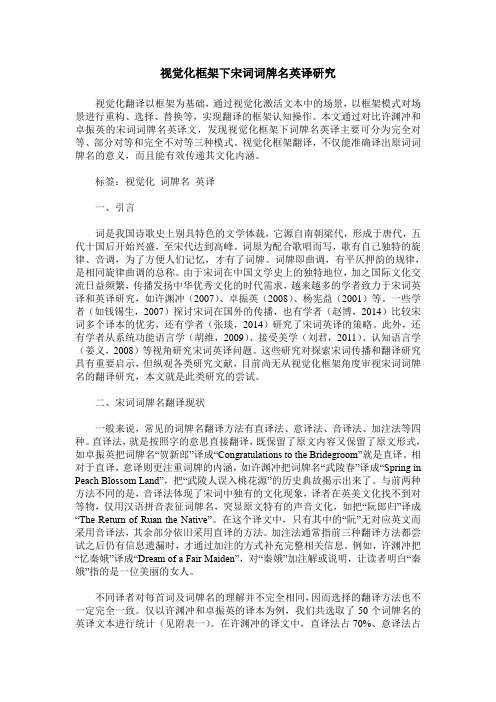
视觉化框架下宋词词牌名英译研究视觉化翻译以框架为基础,通过视觉化激活文本中的场景,以框架模式对场景进行重构、选择、替换等,实现翻译的框架认知操作。
本文通过对比许渊冲和卓振英的宋词词牌名英译文,发现视觉化框架下词牌名英译主要可分为完全对等、部分对等和完全不对等三种模式。
视觉化框架翻译,不仅能准确译出原词词牌名的意义,而且能有效传递其文化内涵。
标签:视觉化词牌名英译一、引言词是我国诗歌史上别具特色的文学体裁,它源自南朝梁代,形成于唐代,五代十国后开始兴盛,至宋代达到高峰。
词原为配合歌唱而写,歌有自己独特的旋律、音调,为了方便人们记忆,才有了词牌。
词牌即曲调,有平仄押韵的规律,是相同旋律曲调的总称。
由于宋词在中国文学史上的独特地位,加之国际文化交流日益频繁,传播发扬中华优秀文化的时代需求,越来越多的学者致力于宋词英译和英译研究,如许渊冲(2007)、卓振英(2008)、杨宪益(2001)等。
一些学者(如钱锡生,2007)探讨宋词在国外的传播,也有学者(赵博,2014)比较宋词多个译本的优劣,还有学者(张琰,2014)研究了宋词英译的策略。
此外,还有学者从系统功能语言学(胡维,2009)、接受美学(刘君,2011)、认知语言学(姜义,2008)等视角研究宋词英译问题。
这些研究对探索宋词传播和翻译研究具有重要启示,但纵观各类研究文献,目前尚无从视觉化框架角度审视宋词词牌名的翻译研究,本文就是此类研究的尝试。
二、宋词词牌名翻译现状一般来说,常见的词牌名翻译方法有直译法、意译法、音译法、加注法等四种。
直译法,就是按照字的意思直接翻译,既保留了原文内容又保留了原文形式,如卓振英把词牌名“贺新郎”译成“Congratulations to the Bridegroom”就是直译。
相对于直译,意译则更注重词牌的内涵,如许渊冲把词牌名“武陵春”译成“Spring in Peach Blossom Land”,把“武陵人误入桃花源”的历史典故揭示出来了。
框架语义学视角下古诗词翻译研究

框架语义学视角下古诗词翻译研究本文以框架语义学为视角,对比于谦《石灰吟》的英译本,论证译语框架与源语框架的重合、包容、相交及独立的框架关系,探讨框架语义学对古诗词英译的运作机制。
标签:框架语义学框架关系古诗词翻译一、引言自20世纪70年代认知语言学兴起以来,一些学者开始关注认知语言学与翻译研究的关系,如认知语言学对翻译的解释力(李宏、王寅,2005)、认知体验的等值翻译研究(宋德生,2005)、认知语言学对翻译的影响力(萧立明,2005)。
这些研究从宏观角度诠释了认知语言学与翻译的关系。
与此同时,一些学者亦开始用框架语义学等具体认知语言学理论来研究翻译,如俞荷晶(2008)从框架语义学角度论证了翻译研究的可行性与必要性,刘国辉(2010)阐释了翻译“三步曲”中框架语义认知的重要性,轩志峰(2011)则论证了框架语义学在原语文本和译语文本中的功能,讨论了翻译中语义框架重现、再塑等问题。
尽管如此,运用框架语义学理论探究英译的具体运作机制的文献并不多见,对古诗词的英译实证对比研究则更少。
本文以古诗词《石灰吟》的英译实践本为例,着重探讨框架语义学在古诗词英译中的运作机制。
二、框架语义学20世纪70年代后期,美国语言学家Charles Fillmore提出的框架语义学,为人们理解和描述词项(lexical item)意义及语法构式(grammatical construction)提供了一个新视角。
该理论强调,对词义的描述,首先依赖于概念构建,因此,概念构建为词在语言和言语中的存在和使用提供了背景及动因(Johnson et al,2001)。
框架语义学出自经验主义语义学传统,强调语言与经验之间的连续性,通过框架来展现经验主义语义学的研究成果。
框架可以是任何一个概念体系,各概念之间相互关联,要理解该体系中的任何一个概念,就必须理解整个概念体系。
换言之,该体系中任何一个概念都会激活其他概念。
框架语义学中,一个词代表一个经验范畴,而该范畴可以用在不同的语境中,这些语境是由该词的某个典型用法的多个方面决定的。
框架理论视角下《诗经·桃夭》的翻译认知阐释——以庞德和许渊冲的译本为例
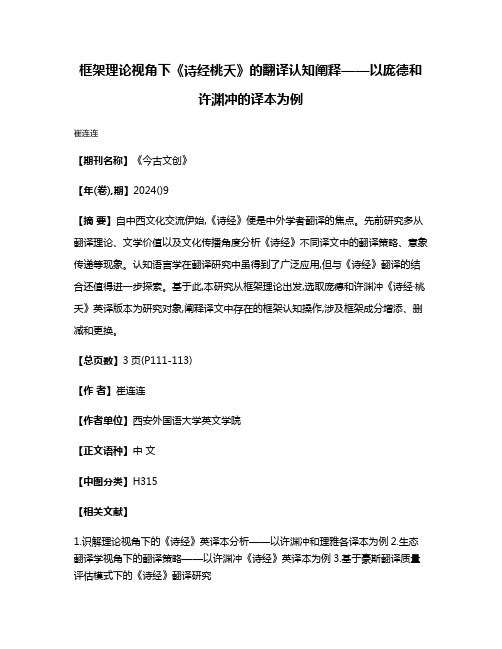
框架理论视角下《诗经桃夭》的翻译认知阐释——以庞德和
许渊冲的译本为例
崔连连
【期刊名称】《今古文创》
【年(卷),期】2024()9
【摘要】自中西文化交流伊始,《诗经》便是中外学者翻译的焦点。
先前研究多从翻译理论、文学价值以及文化传播角度分析《诗经》不同译文中的翻译策略、意象传递等现象。
认知语言学在翻译研究中虽得到了广泛应用,但与《诗经》翻译的结合还值得进一步探索。
基于此,本研究从框架理论出发,选取庞德和许渊冲《诗经·桃夭》英译版本为研究对象,阐释译文中存在的框架认知操作,涉及框架成分增添、删减和更换。
【总页数】3页(P111-113)
【作者】崔连连
【作者单位】西安外国语大学英文学院
【正文语种】中文
【中图分类】H315
【相关文献】
1.识解理论视角下的《诗经》英译本分析——以许渊冲和理雅各译本为例
2.生态翻译学视角下的翻译策略——以许渊冲《诗经》英译本为例
3.基于豪斯翻译质量评估模式下的《诗经》翻译研究
——以《诗经·桃夭》和许渊冲译本为例4.乔治·斯坦纳阐释学翻译观视角下译者主体性的研究——以许渊冲《水调歌头》英译本为例5.接受美学视域下《长干行·其一》翻译对比研究——以许渊冲和庞德的英译本为例
因版权原因,仅展示原文概要,查看原文内容请购买。
- 1、下载文档前请自行甄别文档内容的完整性,平台不提供额外的编辑、内容补充、找答案等附加服务。
- 2、"仅部分预览"的文档,不可在线预览部分如存在完整性等问题,可反馈申请退款(可完整预览的文档不适用该条件!)。
- 3、如文档侵犯您的权益,请联系客服反馈,我们会尽快为您处理(人工客服工作时间:9:00-18:30)。
ISSN 1799-2591Theory and Practice in Language Studies, V ol. 2, No. 6, pp. 1141-1146, June 2012© 2012 ACADEMY PUBLISHER Manufactured in Finland.doi:10.4304/tpls.2.6.1141-1146Application of Frame Theory in Translation of Connotation in Chinese Ancient PoemsMingjun Y aoBeijing Forestry University, Beijing, ChinaEmail: yaomingjun1987@Abstract—Chinese ancient poems give prominence to the property of Chinese language that lay focus on theconnotation beyond linguistic expressions. There has been long debate on which strategy should be chosenamong literal or liberal translation and domestication or foreignization in translation community especiallyconcerning cultural factors like translation of Chinese ancient poems. Frame theory provides a newperspective on the long debate of translation strategies, it illuminates on the translators that proper linguisticexpressions should be found in target language to activate the identical or similar frames to those of in thesource language.Index Term s—frame, Chinese ancient poems, cultural frames, connotation, translationI.I NTRODUCTIONTranslation studies have evolved greatly, increasingly taking on the interdisciplinary features. Anthropology, comparative linguistics, psycho-linguistics, socio-linguistics have been applied to illustrate translation studies by many scholars. The complication of translation process implies such a trend. Also the high frequency of intercultural communication has intensified this trend with the result that communicative perspective has become an important component in translation studies. The frame theory that would be applied in this paper on translation is compatible with the trend in translation studies. And it is also an effective communicative perspective in probing into translation, because translation is a cross-cultural activity essentially, and frame theory takes great consideration into cultural differences, which will be expounded on the following. According to Deng Jing (2010), the complicated translation process is not a simple activity of superficial linguistic decoding and encoding or rigid switches between languages. The author‟s intention, the target receiver‟s ex pectation and the translator‟s interpretation of the two sides should be taken due attachment. The new illumination on translation implies that studies on translation shouldn‟t be confined to superficial text or intra-linguistic aspect, and culture, societ y, politics as well as the translator‟s mental state should be components of translation studies.Frame theory absorbed viewpoints from linguistics, psychology and artificial intelligence, comprehensively considering context, stereotype, perception and experience of agent. Therefore it can provide brand-new illumination on the complicated translation process and be high of value in studies on strategies of translation. However, the frame theory‟s application in translation studies is not as nourishing as expected (Deng, 2010). The review on the past literature on the application of frame in translation studies indicates that influential studies in such a perspective is rare and frame theory has not given a full play in translation studies. It is universally acknowledged that Chinese attaches great importance on expression of connotation or implicit meaning beyond superficial linguistic level, a semotactic language, which is opposite with English which has strict grammatical forms in expression, a morphotactic language. Chinese ancient poems, as the highly condensed Chinese, are laden with a sea of implicit meanings that should be fully grasped when translated into English. Successful convey of meaning of Chinese poems necessitates appropriate strategies or the target receiver would fail to feel the artistic conception disguised in the original poems.The major task of translation of Chinese ancient poems is to perceive the implicit semantic relation and cultural information between lines. The paper will mainly explore strategies in translation of Chinese ancient poems by the application of frame theory.II.F RAME T HEORYFrame theory was developed by Charles Fillmore with the purpose of showing a cognitive model for languages. Languages users interpret their surroundings, convey and comprehend messages and so on all according to their internalized frames. It gives prominence to the relationship between what a speaker says and the context in which he says it.A. Notion of FrameFillmore‟s notion of frame originates from work conducted by Marvin Minsky, a computer expert in artificial intelligence in the 1970s. Concerning the notion of frame, Fillmore has given a series of definition of it. Initially, in1975, Fillmore first defined the notion of frame as any system of linguistic choices-the easiest cases being collections of words, but also including choices of grammatical rules of linguistic categories –that can get associated with prototypical instances of scenes (Ungerer& Schimid, 2008). Such a definition means that a frame was regarded as any array of linguistic options which were connected with the “scenes”, a notion similar to the term situation. The original notion of frames was indicative of a fact that frames has shifted towards cognitive interpretation. In 1985, Fillmore says that frames are specific unified frameworks of knowledge or coherent schematizations of experience. Still more recently he views frames as …cognitive structures […] knowledge of which is presupposed for the concepts en coded by the words‟. The universally accepted notion of frame is that a frame is to be seen as a type of cognitive model which represents the knowledge and beliefs pertaining to specific and frequently recurring situation.What this collection of definitions and explanations shows is that while frames were originally conceived as linguistic constructs, they have by now received a cognitive reinterpretation.B. Features of FrameFrom the analysis of our familiar commercial event frame [BUY] (because the [BUY] frame is so classic and familiar, here some details would be omitted), some features of frame can be derived(Wang, 2005).Firstly, different cognitive perspectives within the same frame would result in different linguistic expressions. The verbs buy and pay describe the commercial event from the buyer‟s perspective, while sell and charge describe the situation from the seller‟s perspective. So the linguistic expression s would be different when different perspectives are adopted.Secondly, components of a frame are basic and steady. In the classic commercial event frame, the basic and steady components are buyer, seller, goods and money, and accordingly in the [DANGER] frame, they are victim, tools and places.Thirdly, all components which constitute the network of frames are closely connected. Once a component is mentioned, it will activate the whole cognitive frame. For instance, the word buy in commercial event frame would activate a whole bundle of other components which belong to the same frame. People grasp the meaning of the linguistic expressions largely depending on the activation of cognitive frames.C. Frame System and Sub-framesAny component of a frame can activate the whole frame which the component belongs to. In the [FLYING A PLANE] frame, the cognitive component plane would activate a whole bundle of other components which belong to the same [FLYING A PLANE] frame, such as pilot, flight attendant, life vest, safety belt, first class, economy class, safety instructions and so on. All these components and the specific relations that exist between them are part of the frame. But different components which activate the same frame would produce different perspectives. Such differences would lead to different frames in the same system. These different frames in the same system are regarded as frame system. Moreover, there are many so-called sub-frames which capture the knowledge of still more specific situations of a flight, such as [EA TING], [W A TCHING THE MOVIE] and [GOING TO THE TOILET]. Cognitive components play a major role within frames. Broadly speaking, components act as both anchors and triggers for frames, because it is in the format of components and their interrelations that frames are designed and it is by the same components that they are activated. A frame is composed of slots to which explicit or implicit information will be assigned when the frame is activated. As far as ancient Chinese poems concerned, more implicit information will be assigned. It indicates a further function of components is to provide so-called …default assignments‟ (i.e. values for slots in the frame that apply under …normal‟ conditions) by supplying context-dependent prototypes. For example, in the sub-frame of [EA TING ON A PLANE] you will not expect to have your meal served on a huge dinner-table, set with expensive table-ware and a candle. As far as food and drinks concerned you will presumably not reckon with a gourmet meal accompanied by a vintage wine (unless you are used to flying first class). And it should be clear that the “default value” is also influenced by culture. Even the same frame will have different default value for cultural differences. For example, [CROW] in Chinese culture would be provided with default value-“hoodoo” or “bad luck”, but in Japa nese culture, [CROW] would be provided with default value-“auspiciousness”. All these expectations that are based on our experience and stored in our long-term memory and influenced by specific cultural context are part of the frame-system and will influence our ability to produce and understand the related language.Sub-frame and frame-system of [FLYING A PLANE] have no differences among all the languages, because the situation of flying a plane is almost the same all over the world. On the other hand, since people from different races, different regions or different languages have obviously different experiences, which have heavily influenced people‟s cognition, frame system and sub-frames. These different experiences would produce misunderstandings when communications take place between people from different races, places and language communities.D. Frame and CultureFrame is on the basis of conventional cultural knowledge, and more importantly, knowledge stored in a frame would be shared by a group of people in a language community. It proves that frame has innumerable links with culture. People living in the same culture share the same historic background and similar geographic condition. Their semblance of experience would produce the probability that they share the same frames to the same event.Moreover, there are many frames shared by the people all over the world, but in view of differences of experience, some frames are unique to specific cultural groups. Generally, on the basis of cultural differences, there are three situations concerning the different frames. Initially, there are frames shared by the largest number of people all over the world, such as [CINEMA] and [FLYING A PLANE]; The second are the frames that are unique to some specific cultures, for example, [KABUKI], it is unique to Japanese culture. The third are the frames that are shared by large numbers of people but differences can be perceived too, such as [FAMILY], in Chinese and English culture [FAMILY] all includes father and mother, but differently, in Chinese, it also comprises a child and grandparents, and in English culture it also includes children that has not been married and even their pet dogs,however, [FAMILY] in English culture doesn‟t include grandparent.Take an example of English-Chinese translation: Do you have a family?The sentence can‟t be translated as “你有家庭吗1?” or “你成家了吗?”. The correct translation is “你有孩子了吗2?”. The incorrect translation results from not being clear about the differences lying in the shared frame.III.F RAME T HEORY AND C HINESE A NCIENT P OEMS T RANSLA TIONIt can be said t hat frame is a kind of implicit expression in a specific culture. In other words, frame can‟t be traced in linguistic expression structure, deeply ingrained in deep structure to organize knowledge so as to make linguistic expression sense in a specific cultural context. This point is conducive to the translation of Chinese ancient poems. True meaning of Chinese ancient poems is always obscured between lines; the translator should correctly grasp the knowledge of deep structure in the frame expressed in the poems and then seek the similar frames that can activate the artistic conception that is in line with the original poems to the target receiver in target language culture. According to the illustration of frame theory, the translator should initially have correct interpretation to the original poems depending on the stored or established frames in his mind and then find proper denotation of English language to reconstruct the poems so as to facilitate the target receivers‟ activation of the same or similar frame in their mind. The following sections are some translation examples on Chinese ancient poems by applying frame theory.A. Creation of Frames to Convey ConnotationChinese ancient poems are replete with specific cultural factors. Poets never thought that their poems would be disseminated into English culture. The shared knowledge between the poets and readers are left out in the poems. Chinese linguistic symbols activate the frames accordingly in the readers‟ mind. The default value filling the blanks in the poems enables the Chinese readers to understand the meaning in deep structure and appreciate the “beauty of artistic conception”. The English readers are foreign to many Chinese cultural factors, the same frame may not activate the same frame in their mind, and so to attain the same effect on the English readers as on Chinese readers, the translator has to create new frames to convey the implicit meaning in Chinese ancient poems.Sample1.鹊桥仙-秦观纤云弄巧,飞星传恨,银汉迢迢暗渡。
